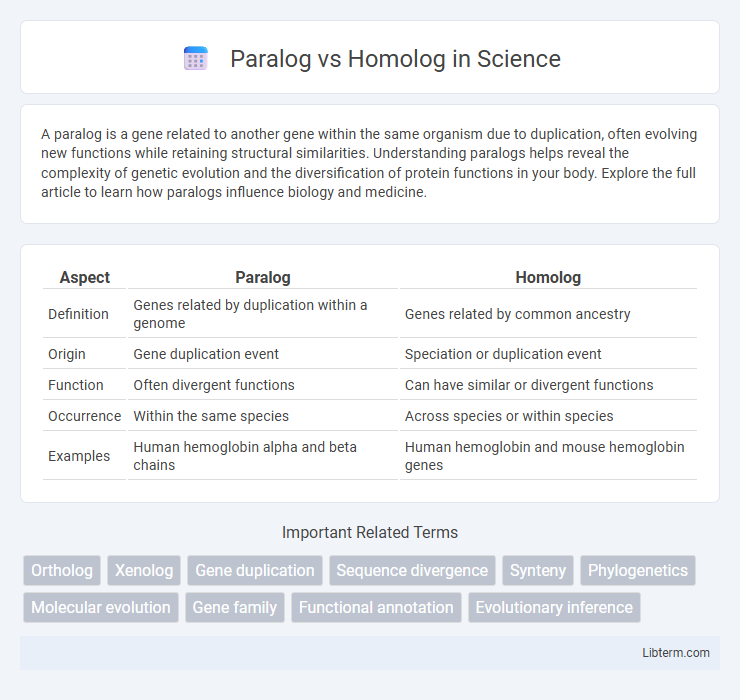A paralog is a gene related to another gene within the same organism due to duplication, often evolving new functions while retaining structural similarities. Understanding paralogs helps reveal the complexity of genetic evolution and the diversification of protein functions in your body. Explore the full article to learn how paralogs influence biology and medicine.
Table of Comparison
| Aspect | Paralog | Homolog |
|---|---|---|
| Definition | Genes related by duplication within a genome | Genes related by common ancestry |
| Origin | Gene duplication event | Speciation or duplication event |
| Function | Often divergent functions | Can have similar or divergent functions |
| Occurrence | Within the same species | Across species or within species |
| Examples | Human hemoglobin alpha and beta chains | Human hemoglobin and mouse hemoglobin genes |
Introduction to Paralog and Homolog
Paralogs and homologs are terms used to describe genes related by evolutionary history. Paralogous genes arise from gene duplication events within the same species, leading to gene families with potentially diverse functions. Homologous genes include both paralogs and orthologs, encompassing all genes descended from a common ancestral sequence, regardless of species.
Defining Homologous Genes
Homologous genes are defined as genes inherited from a common ancestor that retain related sequences and functions across different species. Paralogous genes are a type of homolog that arise from gene duplication events within the same organism, often diverging to acquire new functions. Understanding these distinctions is critical in evolutionary biology and comparative genomics for tracing gene family expansions and functional diversifications.
Understanding Paralogous Genes
Paralogous genes arise from gene duplication events within a single genome, resulting in gene copies that may evolve novel functions while retaining sequence similarity. These genes contrast with homologous genes in different species, known as orthologs, which diverged after a speciation event. Understanding paralogous genes is essential for studying gene family expansion, functional diversification, and evolutionary adaptation in organisms.
Mechanisms of Gene Duplication
Paralogs arise from gene duplication events within the same genome, often through mechanisms such as unequal crossing over, retrotransposition, or whole-genome duplication, resulting in gene copies that evolve new functions. Homologs, in contrast, include both paralogs and orthologs; while paralogs diverge after duplication in one species, orthologs diverge after speciation events between different species. Understanding gene duplication mechanisms like segmental duplication and tandem duplication provides crucial insights into how paralogs contribute to genomic complexity and functional diversity.
Types of Homology: Orthologs, Paralogs, and Analogs
Orthologs are genes in different species that evolved from a common ancestral gene through speciation and typically retain similar functions, while paralogs arise from gene duplication events within the same genome, often diverging to acquire new functions. Analogs, in contrast, are genes or proteins that perform similar functions but do not share a common evolutionary origin, exemplifying convergent evolution. Understanding these distinctions is crucial for interpreting genetic relationships and functional predictions in comparative genomics and evolutionary biology.
Evolutionary Significance of Paralogs and Homologs
Paralogs arise from gene duplication events within the same species, enabling evolutionary innovation by acquiring new functions while preserving original roles, which enhances adaptability and complexity. Homologs, including both paralogs and orthologs, reflect common ancestry, providing crucial insight into evolutionary relationships and functional conservation across different species. Studying paralogs and homologs reveals mechanisms of gene diversification and evolutionary pressures shaping genomes.
Identifying Paralogs vs Homologs in Genomic Analysis
Paralogs and homologs are identified in genomic analysis through sequence similarity and evolutionary lineage, with paralogs arising from gene duplication events within the same species, whereas homologs include both paralogs and orthologs (genes diverged by speciation). Distinguishing paralogs involves phylogenetic tree reconstruction to trace gene duplication points, while homolog identification relies on conserved motifs and domain architectures across species. Advanced bioinformatics tools such as BLAST for sequence comparison and OrthoFinder for orthology inference improve the accuracy of detecting paralogous and homologous relationships in complex genomes.
Functional Divergence of Paralogous Genes
Paralogous genes arise from gene duplication events and often undergo functional divergence, resulting in distinct, specialized roles within an organism. This divergence is driven by accumulation of mutations in coding or regulatory regions, allowing paralogs to adapt to different physiological processes or environmental conditions. Functional divergence of paralogs contrasts with homologous genes from speciation events, which typically retain similar functions across species.
Applications in Comparative Genomics
Paralogs and homologs are critical in comparative genomics for understanding gene family evolution and functional divergence. Paralogs arise from gene duplication events within a genome and provide insights into species-specific adaptations, while homologs represent genes derived from a common ancestor, facilitating cross-species functional annotation. Analyzing paralogous and homologous gene sequences enables refinement of phylogenetic relationships and identification of conserved genetic elements across diverse organisms.
Summary: Key Differences between Paralog and Homolog
Paralogs are genes related by duplication within a genome, often evolving new functions, while homologs refer broadly to genes sharing a common ancestry, including both paralogs and orthologs. Homologous genes indicate evolutionary relationships, with orthologs diverging after speciation and paralogs diverging after gene duplication. Key differences lie in their evolutionary origin and functional divergence: paralogs arise from duplication events with potential functional innovation, whereas homologs encompass all related genes from common descent across species.
Paralog Infographic

 libterm.com
libterm.com